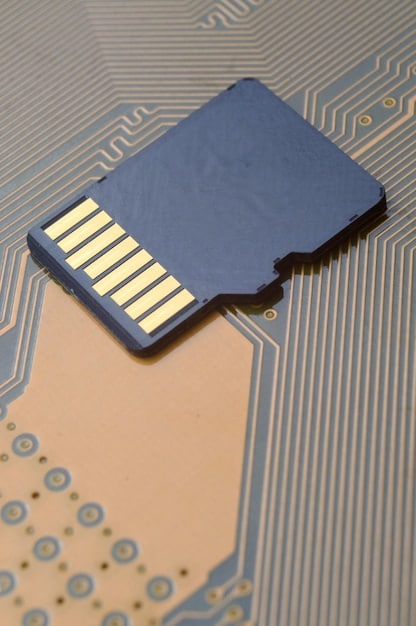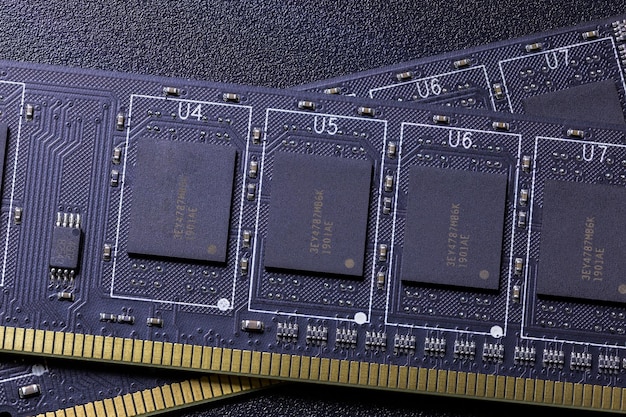NVMe vs SATA: Understanding the Different Types of SSDs

Understanding the Different Types of SSDs: NVMe vs. SATA involves comparing their interfaces, speeds, latency, and suitability for various computing needs, helping users choose the right storage solution for optimal performance.
Choosing the right solid-state drive (SSD) can significantly impact your computer’s performance. Understanding the Different Types of SSDs: NVMe vs. SATA is crucial for making an informed decision. Let’s delve into the details.
Understanding SSD Technology: A Brief Overview
Solid-state drives (SSDs) have revolutionized data storage, offering faster speeds and greater durability compared to traditional hard disk drives (HDDs). Understanding the underlying technology helps in appreciating the differences between NVMe and SATA SSDs.
What is an SSD?
An SSD stores data on flash memory chips, enabling quicker access times and reduced latency.
How SSDs Work
SSDs use NAND flash memory to store data. Unlike HDDs, they have no moving parts, offering better resistance to physical shock and faster data retrieval.

Choosing the right SSD depends on your specific needs and budget. Now, let’s dive into the distinctions between NVMe and SATA SSDs.
SATA SSDs: The Traditional Standard
SATA SSDs have been the standard in solid-state storage for years, providing a significant upgrade over traditional hard drives. However, technology advances and NVMe SSDs now offer even more performance.
What is SATA?
SATA (Serial ATA) is an interface standard for connecting storage devices to a computer’s motherboard.
Performance and Limitations
SATA SSDs are faster than HDDs, but their performance is limited by the SATA interface, with a maximum theoretical bandwidth of 6 Gbps.
- Pros: Wide compatibility, lower cost, and a good upgrade from HDDs.
- Cons: Slower speeds compared to NVMe drives, limited by the SATA interface.
SATA SSDs remain a viable option for many users due to their cost-effectiveness and broad compatibility. They offer a substantial improvement over HDDs for everyday tasks.
NVMe SSDs: The Speed Champions
NVMe (Non-Volatile Memory Express) SSDs are designed to provide the highest possible performance for demanding applications. They leverage the PCIe interface, offering significantly faster speeds than SATA SSDs.
What is NVMe?
NVMe is a communication protocol designed specifically for SSDs, allowing them to take full advantage of the PCIe interface.
Performance and Advantages
NVMe SSDs offer significantly higher read and write speeds compared to SATA SSDs, resulting in faster boot times, quicker application loading, and improved overall system responsiveness.

NVMe SSDs are ideal for gaming, video editing, and other performance-intensive tasks. However, their higher cost may be a deterrent for some users.
Key Differences: NVMe vs. SATA SSDs
Understanding the key differences between NVMe and SATA SSDs involves comparing their interfaces, speed, latency, and cost. Each type has its advantages and disadvantages, making the choice dependent on specific requirements and budget.
Interface and Protocol
SATA SSDs use the SATA interface, while NVMe SSDs use the PCIe interface. NVMe also employs a protocol optimized for SSDs, reducing latency and improving performance.
Speed and Latency
NVMe SSDs offer significantly higher read and write speeds, with lower latency compared to SATA SSDs. This results in faster application loading and improved overall system responsiveness.
Cost and Availability
SATA SSDs are generally more affordable and widely available. NVMe SSDs are more expensive but offer superior performance.
Choosing between NVMe and SATA SSDs depends on your performance requirements and budget. NVMe drives offer the best performance, while SATA drives provide a cost-effective upgrade over HDDs.
Practical Applications: Choosing the Right SSD
The right SSD depends on your needs. NVMe SSDs are the best for demanding tasks, while SATA SSDs are better for budget-conscious upgrades.
Gaming
NVMe SSDs provide faster loading times and smoother gameplay. However, SATA SSDs can still offer a decent gaming experience at a lower cost.
For gamers seeking the ultimate in performance, NVMe SSDs are the preferred choice. They reduce loading times and improve overall system responsiveness.
Video Editing and Content Creation
NVMe SSDs offer faster data transfer rates. They are better for editing video and rendering content.
- NVMe Advantage: NVMe’s superior speeds mean less waiting and more creating.
- SATA Limitation: SATA may struggle with large files.
- Considerations: Budget and project scale matter.
If video editing is crucial, consider NVMe.
Future Trends in SSD Technology
SSD technology is always advancing. These trends point to even faster and more efficient drives.
PCIe Gen5 and Beyond
Newer PCIe generations promise even higher bandwidth, further boosting NVMe SSD performance.
QLC and PLC NAND
QLC (Quad-Layer Cell) and PLC (Penta-Layer Cell) NAND technologies increase storage density but may affect endurance.
Software Innovations
Advanced caching algorithms and firmware optimizations enhance SSD performance and lifespan.
Innovations ensure SSDs will remain at the forefront of storage.
| Key Point | Brief Description |
|---|---|
| 🚀 NVMe Speed | Higher read/write speeds boost performance. |
| 💰 SATA Cost | SATA SSDs Offer Budget-friendly Storage Solutions. |
| 🎮 Gaming | NVMe reduces load times, SATA is a budget alternative. |
| 💻 Interface | NVMe uses PCIe; SATA uses the SATA interface. |
Frequently Asked Questions
▼
The main difference is the interface: NVMe utilizes PCIe for faster speeds, while SATA uses the older SATA interface, limiting its performance.
▼
NVMe offers superior speeds but is pricier. SATA is a budget-friendly option, sufficient for most general tasks. It depends on your needs.
▼
Not all motherboards support NVMe. Check your motherboard’s specifications for M.2 slots and NVMe compatibility before purchasing an NVMe SSD.
▼
Yes, an NVMe SSD can significantly speed up boot times, application loading, and overall system responsiveness, especially if your system is currently using a traditional HDD.
▼
Reliability depends on the specific drive and manufacturer. Both NVMe and SATA SSDs are generally more durable than HDDs. Check the TBW rating for longevity.
Conclusion
Understanding the nuances of NVMe and SATA SSDs empowers you to choose the storage solution that aligns with your performance needs and budget. While NVMe drives offer unparalleled speed for demanding applications, SATA SSDs remain a reliable and cost-effective choice for everyday computing.





